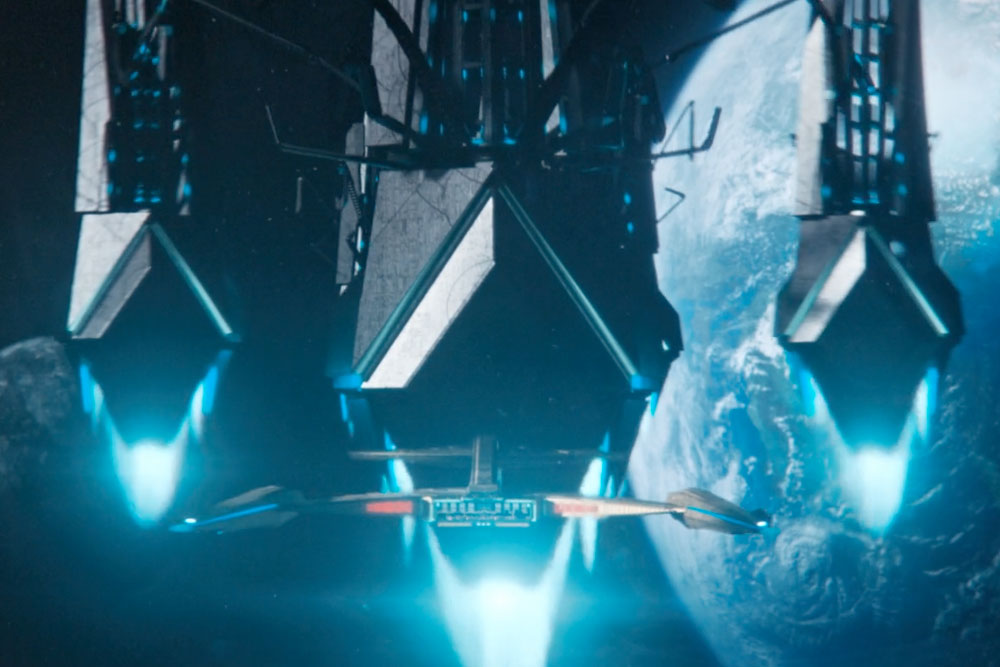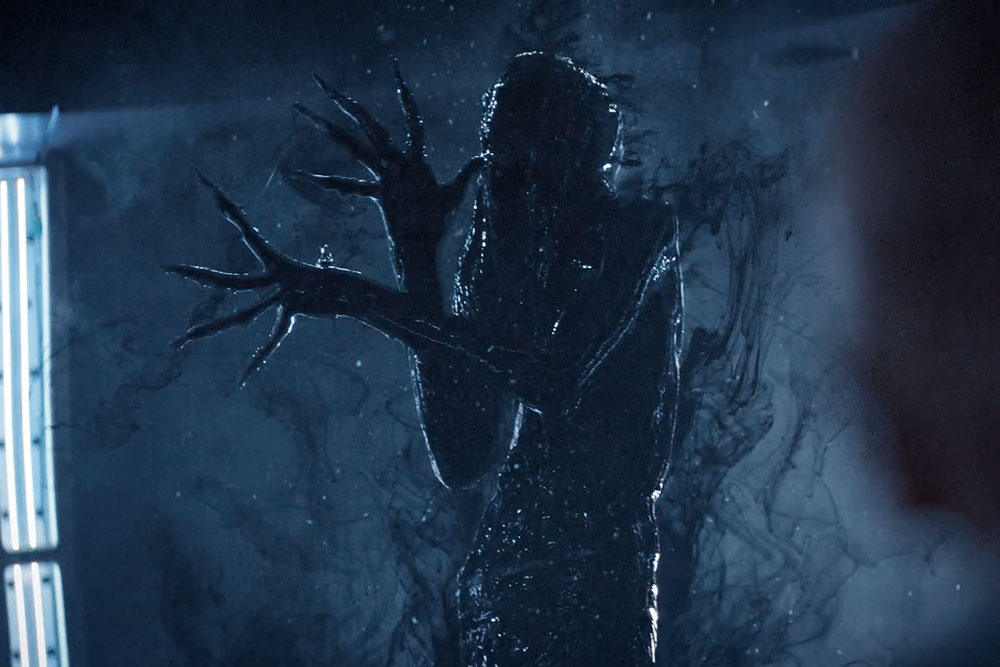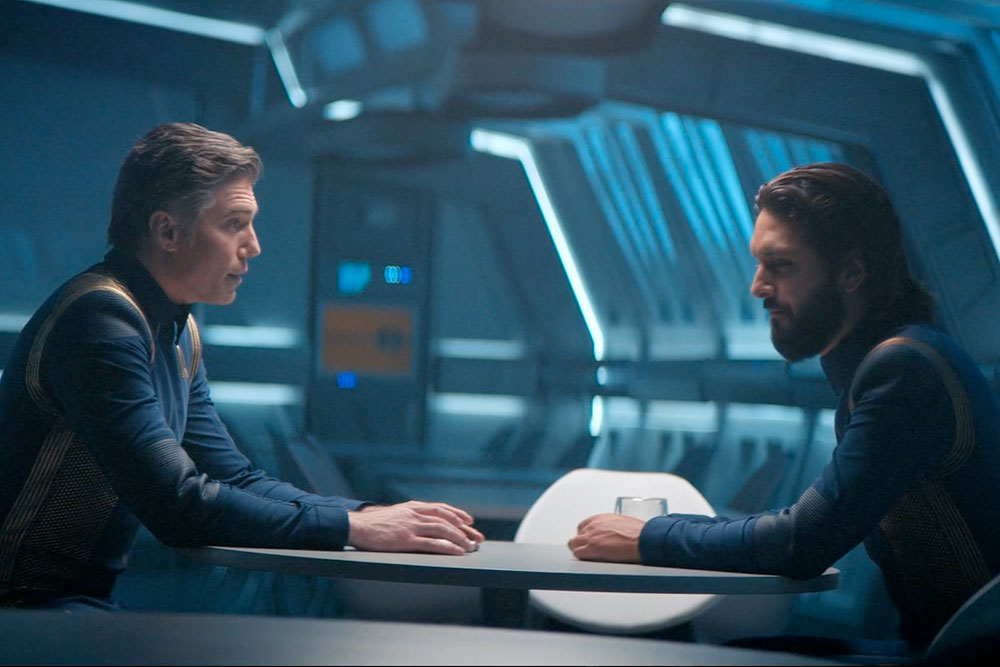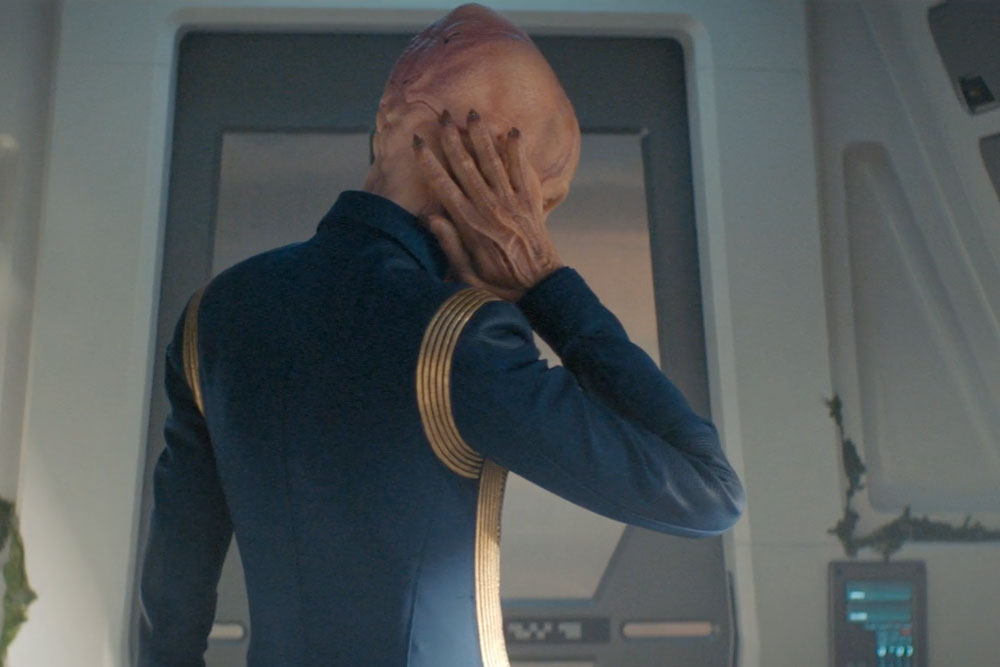In this week’s Star Trek: Discovery, “The Sound of Thunder” tackles the impact of Saru’s vahar’ai on the people of Kaminar, following his unexpected transformation in “An Obol for Charon” earlier this season.
It’s a story we knew would be told eventually, but unfortunately “The Sound of Thunder” tells it too soon — and too quickly. Unlike most episodes, which have had ‘A,’ ‘B,’ and sometimes ‘C’ stories all cross-cutting one another, the run time of “The Sound of Thunder” is almost entirely focused on one relatively straightforward story.
Even so, this episode felt so rushed that at one point, I wondered if my screener was missing a few scenes or had skipped ahead without realizing it.

Another new red signal appears, this time above the Kelpien homeworld of Kaminar, which we last visited in December’s Short Trek, “The Brightest Star.” Despite the restriction on visiting the planet that Georgiou told us about in the short, Captain Pike (Anson Mount) immediately sets Discovery on course.
Once they arrive, Saru’s (Doug Jones) new and more assertive temperament becomes apparent when the mysterious Ba’ul warn Discovery away from the planet. Disagreeing with Pike’s decision not to send him to the planet’s surface with Michael Burnham (Sonequa Martin-Green), Saru snaps at the captain in an increasingly uncomfortable display that verges on insubordination.
Pike backtracks on his decision and allows Saru to accompany Burnham, but only under strict orders not to reveal the true nature of the vahar’ai — they’ll “stretch General Order 1,” he says, but not “break it.”

In what is easily the most successful scene of the episode, melancholy pours off of Saru as he shows Burnham around the outskirts of his superficially idyllic lakeside village. (Side note: I do not know how Doug Jones walked on the loose sand of that shoreline in those hoof shoes.)
Sirrana’s (Hannah Spear) reaction to learning that her brother has been traveling the stars since his disappearance 18 years prior — and has brought an alien colleague home with him — is simply delightful. Instead of fear, she greets Burnham with warmth and welcome. Saru and Burnham learn that Sirrana saw the red signal in Kaminar’s sky, and beam back to Discovery to report their findings.
The Ba’ul, the predator species who have placed ‘Eye of Sauron’-style spires in each village — which the Kelpiens call “The Watchful Eye” — learn of Saru’s place aboard Discovery, and break their previous silence to demand Saru’s return from Starfleet custody.

Using only audio communication, the Ba’ul’s hissing, gravelly voice immediately comes across as cartoonishly sinister, like a goth teenager using a cheap voice distorter from a Halloween store to try and scare the neighbor’s kids. (Trust me, I say this from embarrassing personal experience.)
To prevent the Ba’ul from making good on their threat to destroy Saru’s village, Saru defies orders and beams over to a chamber inside one of the Ba’ul ships, which turns out to be located deep under the surface of the lake near his home village.
Finally, we get a chance to see the Ba’ul, and let me tell you, if I thought they sounded cartoonishly sinister they look even worse. Pointier versions of Armus — the tar monster that killed Tasha Yar in Next Generation’s “Skin of Evil” — with a flair for melodramatic hand acting, the Ba’ul check off every single box on the list of “theatrically evil horror movie monster,” and then write in a few more at the end.

The art design of the Ba’ul is so excessive that I thought it must have been deliberately over-the top; for the rest of the episode, I was expecting a surprise twist that played on the human tendency to ascribe sinister motives to monstrous things. Like the salt vampire in “The Man Trap,” or the Horta in “Devil in the Dark,” I thought perhaps this episode was going to demonstrate to the viewer that with context, monstrosity or otherness often does not equal moral evil.
Nothing like that happened though, and instead we were just left with adversaries that looked silly for no reason. I mean, the Ba’ul literally leaves the room by wrapping itself up in its long fingers like a vogue-ing Dracula, sinking back into its tar pit.
Here the story really picks up — to a fault — and massively consequential actions are proposed, decided on, and executed in a matter of minutes. Looking through the data from the sphere the crew encountered the other week, Burnham, Tilly (Mary Wiseman), and Airiam (Hannah Cheesman) find that 2000 years ago, the situation on Kaminar was very different. Post-vahar’ai Kelpiens were common, and Ba’ul were not.

Coming to the conclusion that the Ba’ul were at one time the prey species — and boy, is this a lot of conclusion to draw just from raw population numbers — they propose to free the Kelpiens from subjugation by using Discovery’s technology to immediately trigger the vahar’ai in all Kelpiens.
Pike has misgivings about potentially endangering the Ba’ul (but apparently not about shredding General Order 1!), but accepts Burnham’s dubious assurance that the difference in technological advancement between the two cultures will protect the Ba’ul for a few generations, giving everyone enough time to figure out how to peacefully coexist.
With Saru only able to warn Siranna of the painful surprise about to hit, Pike gives the order and suddenly every Kelpien on the planet is caught in the throes of vahar’ai as their entire cultural and biological understanding of themselves is upended in a matter of agony-wracked minutes.
The Ba’ul respond by powering up their spires with dangerous energy, preparing to exterminate the Kelpien race in retribution, but just as things are at their most bleak, the Red Angel appears outside the window of Saru’s cell and lingers long enough to give him — and us — the distinct impression that the Angel is actually a humanoid in a protective suit.
The Angel then detonates an energy blast, generating an electromagnetic pulse strong enough to disable all of the Watchful Eyes, stopping the Ba’ul attack.. Post-vahar’ai Kelpiens emerge from their tents looking like they just had a nice, relaxing massage instead of appearing as if they just lived through the most significant event of the last 2000 years! — and one that was facilitated by extraterrestrials, knowledge of whose existence alone would be culture-shattering!
After a quick visit to Saru’s quarters aboard Discovery, Siranna happily volunteers to help post-vahar’ai Kaminar find its way — organizing head-dart target practice sessions, maybe? — and Discovery sets off on its next adventure. What do the Ba’ul think of any of this? I don’t know, because we never hear from them again.

The only other storyline that gets any screen time in the episode is a brief scene in sickbay in which Hugh Culber (Wilson Cruz) is visibly disturbed by the realization that after his return from the mycelial network last week, his body is entirely new and that while his mind is still his own, he may not be the same person he once was.
This scene comes at the beginning of the episode and transitions into Saru learning more about his own transformation, tying Culber’s discomfort into the events of the rest of the episode, but not informing them in any way. It’s almost as if Culber’s experience was meant as foreshadowing, but the episode forgot about it and never completed the through-line.
With the signal that appears over Kaminar, any notion that the signal’s locations are random has essentially been put to rest. The question now, as debated between Captain Pike and a back-in-uniform Ash Tyler (Shazad Latif) is whether or not the Red Angel is a benevolent figure. Does it direct would-be saviors to places in need of emergency assistance, like in “New Eden,” or does it cause the emergencies themselves?

As one would expect given their allegiances, Pike takes the more optimistic view, Tyler the more cautious. The episode’s title is a direct reference to the Ray Bradbury short story of (almost) the same name which originated the concept of the “butterfly effect,” the idea that consequences of seemingly insignificant actions can snowball in importance.
Though the Bradbury story concerns the unanticipated effects of a time traveler’s innocent actions unleashed upon the future, I have to wonder if a similar “ripple effect” is being hinted at for Discovery‘s upcoming exploration, either from the (possibly) time-traveling Red Angel, or the sudden Kelpien evolution.
I also wonder why the decision was made to introduce and resolve Saru’s storyline so quickly, and while so much else is happening on the show. Considering how deeply emotional the events of “An Obol for Charon” were for the character, it seems that Saru’s personal journey of understanding how to live his post-vahar’ai life could easily have taken place over the course of an entire season — after which he could be Kaminar’s guide to the new Kelpien existence.

I hope the events of this episode will be revisited, or at least reassessed, later in the season, providing some much-needed conclusions — and consequences. Even if there is payoff in the future, as a standalone episode, “The Sound of Thunder” leaves me cold.
I understand that in serialized storytelling, the “single bite” that is an episode is just one part of the meal, but that bite still needs to be appetizing on its own. If “The Sound of Thunder” retroactively becomes a better hour because of something that happens later, I’ll be pleased, but it’s a risky move to require the viewer to sit in hope of a hypothetical.
To return to my rather clunky meal metaphor, I don’t really want to eat a bite of food that tastes bad, even with assurance from the chef that doing so will make a future bite taste especially good, and in the case of “The Sound of Thunder” that assurance isn’t even there. There has to be a better way to arrange and prepare the ingredients on the plate to avoid such a bitter mouthful.

A few other musings:
- “The Brightest Star” and “The Sound of Thunder” were filmed at the same time, on location at an outdoor set built at Scarborough Bluff outside of Toronto, with Kelpien huts being modeled after the angular look of Saru’s makeup design.
- While there’s something to be said for dynamic camera movement, the constantly-roving Steadicam work in the early-episode sickbay and ready room scenes was really quite jarring. Some of the more creative camera angles seen so far this season have been great, but the rapid spinning around Pike’s desk was certainly a bit dizzying.
- The interior of the Ba’ul vessel, where Saru and Siranna are held captive, is a very obvious redress of the Discovery transporter set — made even more noticeable as Saru beams from Discovery right to the Ba’ul chamber.
- Siranna wears the same flowing white robes of her father Arridor, who was village leader in “The Brightest Star.”
- The red flower of Kaminar, called the “fredalia,” is named in honor of Frederick Kim, Star Trek fan and friend of Discovery writers Bo Yeon Kim and Erika Lippoldt who passed away unexpectedly a few years ago.
- When Saru recounts the tale of his rescue by then-Lieutenant Georgiou, he makes note that she was serving aboard the USS Archimedes, a new ship to Trek canon. While the flashback to her shuttle’s landing is a re-use of footage from “The Brightest Star,” the SHN designator — from the Shenzhou — has been erased from the hull.(The Shenzhou was not mentioned in dialogue in “The Brightest Star,” so this seems to be a VFX correction from the December short.)
Finally, speaking of Lieutenant Georgiou, we wondered why the rules of General Order 1 — which were so strict when it came to her visit to Kaminar in “The Brightest Star” — weren’t much of an issue for Captain Pike, who was ready to send Burnham down to the surface after only a moment’s discussion.
We know many of you may be asking the same thing, so we reached out to episode writers Bo Yeon Kim and Erika Lippoldt for some insight.
Captain Pike’s decision to send a team down to Kaminar isn’t so much the result of a change in General Order One itself as it is a difference in circumstances, and in the captain who is interpreting the rule.
In “The Brightest Star,” Georgiou was just a Lieutenant asking permission to make an exception for Saru. Here, Pike is the captain, and he’s on an express mission to investigate the signals.
Therefore he makes a judgement call to carefully make contact anew, knowing that the Kelpiens have been aware of the existence of warp technology for 20 years now (when the Ba’ul became warp-capable) — but only in order to pursue his stated mission.

That’s it for “The Sound of Thunder,” now it’s time for your take on this week’s episode! Share your thoughts in the comments below, and then watch for more updates through next week as we approach “Light and Shadow,” the next episode of Star Trek: Discovery.



